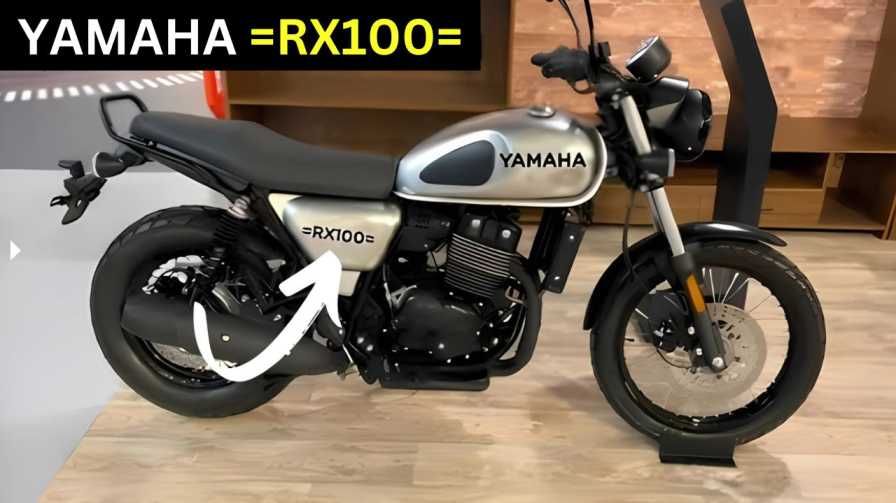The Yamaha RX100, a name synonymous with power, performance, and nostalgia, is set to make waves once again. Renowned for its two-stroke legacy, the RX100 is rumored to be gearing up for a grand comeback, this time with a revolutionary upgrade – a mileage of 65 kmpl. This game-changing revelation pits it directly against the mighty Royal Enfield Bullet, sparking excitement and curiosity among motorcycle enthusiasts across the country.
In this exclusive feature, we delve into the resurgence of the Yamaha RX100, its transformative features, and how it plans to reignite the legacy it left behind decades ago.
The Legacy of the Yamaha RX100
First launched in 1985, the Yamaha RX100 took the Indian market by storm. It wasn’t just a motorcycle; it was a statement. A combination of speed, reliability, and a sleek design catapulted it into the hearts of young riders. Even after its production ceased in 1996, the RX100 remained an icon, with enthusiasts going to great lengths to restore and preserve the bike.
Key Features of the Original RX100:
| Specification | Details |
| Engine | 98cc, two-stroke, air-cooled |
| Power | 11 bhp @ 7,500 rpm |
| Torque | 10.39 Nm @ 6,500 rpm |
| Top Speed | ~100 km/h |
| Mileage | 45-50 kmpl |
| Transmission | 4-speed gearbox |
The combination of its lightweight build, rapid acceleration, and the iconic high-pitched exhaust note made it a favourite among young riders and performance enthusiasts alike.
The Comeback: RX100 Reinvented
Fast forward to 2025, Yamaha is poised to reintroduce the RX100, promising an impressive mileage of 65 kmpl. While specifics about the engine remain under wraps, reports suggest the new RX100 could feature a four-stroke engine compliant with modern emission standards, blending nostalgia with sustainability.
Key Features Expected in the New RX100:
- Engine: Likely a fuel-efficient, eco-friendly single-cylinder four-stroke engine.
- Design: Retaining the classic silhouette with modern enhancements.
- Mileage: 65 kmpl, a significant improvement over the original.
- Technology: Advanced features like ABS, digital instrumentation, and fuel injection.
RX100 vs. Royal Enfield Bullet
The RX100’s biggest challenge – and opportunity – lies in competing with the iconic Royal Enfield Bullet. Known for its rugged design and cult-like following, the Bullet represents the epitome of timeless motorcycling.
Comparison: Yamaha RX100 vs. Royal Enfield Bullet
| Feature | Yamaha RX100 | Royal Enfield Bullet |
| Mileage | 65 kmpl | 35-40 kmpl |
| Engine Type | Likely 150-200cc, single-cylinder | 350cc/500cc, single-cylinder |
| Weight | Lightweight (~110 kg est.) | Heavy (~195 kg) |
| Target Audience | Youth, urban commuters | Long-distance riders, adventurers |
| Price (Est.) | ₹1.5-1.8 lakhs | ₹1.9-2.5 lakhs |
While the Bullet thrives on its thumping exhaust and old-world charm, the RX100 aims to captivate riders with its agility, fuel efficiency, and nostalgic charm combined with modern features.
Why the RX100 Comeback Matters
The return of the RX100 is more than just a product launch; it’s a testament to the enduring love for retro motorcycles in India. The market has seen a surge in demand for bikes that blend classic designs with contemporary technology. The RX100 fits this niche perfectly, promising to appeal to both seasoned riders who long for a slice of nostalgia and younger riders looking for a stylish, high-performance bike.
Environmental Considerations
The shift from a two-stroke engine to a four-stroke engine signifies Yamaha’s commitment to environmental sustainability. Two-stroke engines, while powerful, are notorious for their high emissions. The new RX100 aims to offer cleaner technology without compromising performance.
Steps Yamaha Could Take for Sustainability:
- Electric Variant: Developing an electric version of the RX100 could align with the growing demand for eco-friendly vehicles.
- Hybrid Technology: Combining a fuel-efficient engine with hybrid capabilities might enhance mileage further.
- Carbon Offsetting: Yamaha could introduce programs for tree planting or other initiatives to offset emissions.
Public Reaction and Market Buzz
News of the RX100’s return has set social media abuzz. Enthusiasts have taken to platforms like Instagram and Twitter to share memories of their beloved RX100s, accompanied by the hashtag #RX100Returns. Online forums are rife with speculation about its specifications and pricing, with many hailing it as a “game-changer” for Yamaha.
Challenges Ahead
While the excitement is palpable, Yamaha faces significant challenges in the competitive market:
- Price Sensitivity: Ensuring the RX100 is priced competitively without cutting corners on quality or performance.
- Strong Competition: Rival brands like Honda, Bajaj, and Royal Enfield have a firm foothold in the retro and commuter bike segments.
- Modern Expectations: Striking the right balance between retaining the RX100’s classic charm and incorporating modern features.
A Legacy Reimagined
The Yamaha RX100’s comeback story is one of passion, nostalgia, and innovation. By combining the timeless appeal of the original with advancements in technology, Yamaha is poised to capture the hearts of both old fans and a new generation of riders.
Whether it can dethrone the Bullet or carve its own unique path remains to be seen. But one thing is certain: the RX100 is more than just a motorcycle; it’s a legend reborn.
So, gear up, motorcycling enthusiasts. The RX100 is back – and it’s here to redefine the joy of riding all over again.




